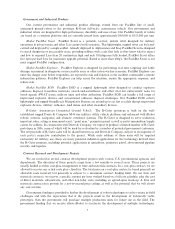iRobot 2005 Annual Report Download - page 21
Download and view the complete annual report
Please find page 21 of the 2005 iRobot annual report below. You can navigate through the pages in the report by either clicking on the pages listed below, or by using the keyword search tool below to find specific information within the annual report.ITEM 1A. RISK FACTORS
We operate in a rapidly changing environment that involves a number of risks, some of which are beyond
our control. This discussion highlights some of the risks which may affect future operating results. These are
the risks and uncertainties we believe are most important for you to consider. Additional risks and
uncertainties not presently known to us, which we currently deem immaterial or which are similar to those
faced by other companies in our industry or business in general, may also impair our business operations. If
any of the following risks or uncertainties actually occurs, our business, financial condition and operating
results would likely suffer.
Risks Related to Our Business
Our future profitability is uncertain, and we have a limited operating history on which you can base your
evaluation of our business.
We have historically incurred significant losses including net losses of $10.8 million and $7.4 million in
the years ended December 31, 2002 and 2003, respectively. As a result of operating losses, we had an
accumulated deficit of $24.3 million at December 31, 2005. Because we operate in a rapidly evolving industry,
we have difficulty predicting our future operating results, and we cannot be certain that our revenue will grow
at rates that will allow us to maintain profitability on a quarterly or annual basis. In addition, we only have a
limited operating history on which you can base your evaluation of our business. If we fail to maintain
profitability, the market price of our common stock will likely fall.
We operate in an emerging market, which makes it difficult to evaluate our business and future
prospects.
Robots represent a new and emerging market. Accordingly, our business and future prospects are difficult
to evaluate. We cannot accurately predict the extent to which demand for consumer robots will increase, if at
all. Moreover, there are only a limited number of major programs under which the U.S. federal government is
currently funding the development or purchase of military robots. You should consider the challenges, risks
and uncertainties frequently encountered by companies using new and unproven business models in rapidly
evolving markets. These challenges include our ability to:
‚ generate sufficient revenue and gross profit to maintain profitability;
‚ acquire and maintain market share in our consumer and military markets;
‚ manage growth in our operations;
‚ attract and retain customers of our consumer robots;
‚ develop and renew government contracts for our military robots;
‚ attract and retain additional roboticists and other highly-qualified personnel;
‚ adapt to new or changing policies and spending priorities of governments and government agencies; and
‚ access additional capital when required and on reasonable terms.
If we fail to successfully address these and other challenges, risks and uncertainties, our business, results
of operations and financial condition would be materially harmed.
Our financial results often vary significantly from quarter-to-quarter due to a number of factors, which
may lead to volatility in our stock price.
Our quarterly revenue and other operating results have varied in the past and are likely to continue to vary
significantly from quarter-to-quarter. For instance, our consumer product revenue is significantly seasonal and,
historically, as much as 75% of our revenue from sales of consumer products has been generated in the second
17
























